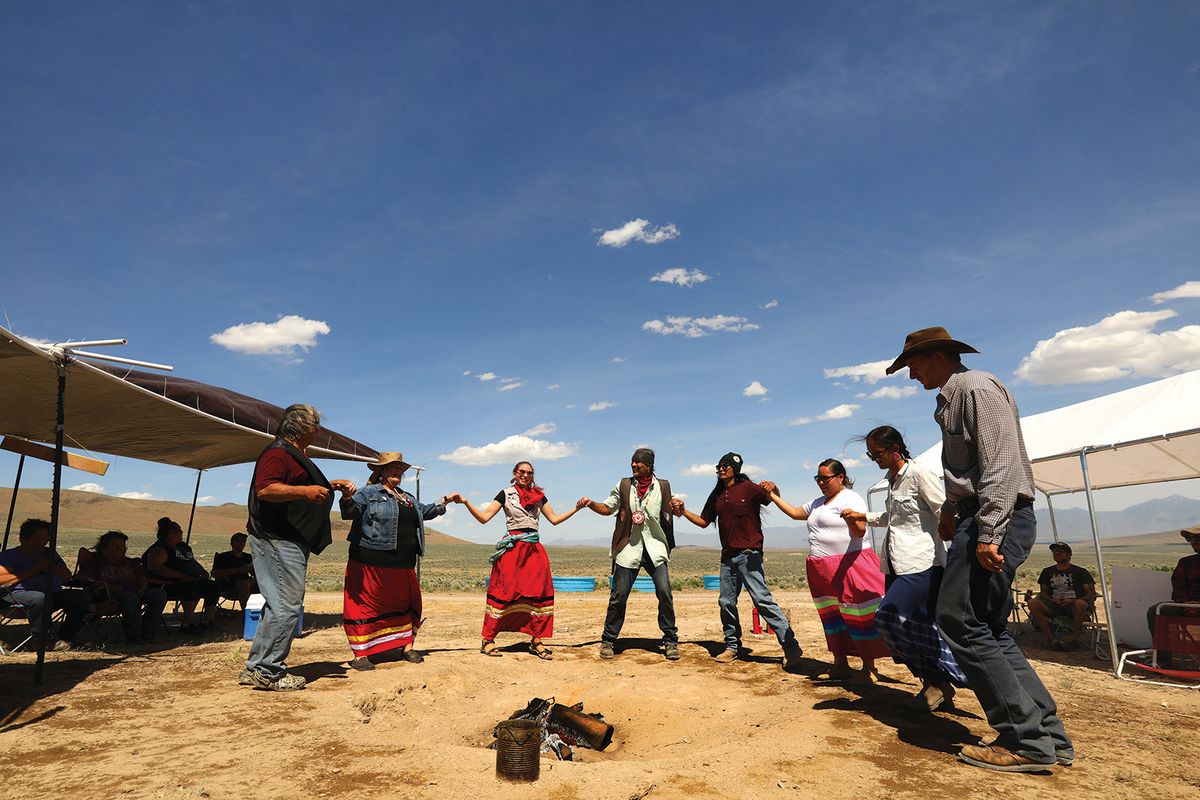The construction of an open-pit lithium mine in northern Nevada, which is scheduled to begin full-fledged operation in 2026, will have irreversible effects on the environment and cultural heritage sites in the region, according to archaeologists, environmentalists and Native American communities who oppose the project.
The site of the Thacker Pass lithium mine, a $2.3bn project that was fast-tracked under the Trump-Pence administration, holds the world’s second largest known deposit of lithium, a so-called “white gold” used to manufacture rechargeable batteries for a range of devices, from mobile phones to electric vehicles.
The Atsa Koodakuh wyh Nuwu (People of Red Mountain) is a grassroots committee made up of Paiute, Shoshone, Bannock and other Native American communities who have been at the forefront of the protests against the Thacker Pass mine. The group says that there are 923 recorded heritage sites in the area, 56 of which may be eligible for listing on the National Register of Historic Places.
“In the Paiute language, Thacker Pass is called Peehee Mu’huh, or Rotten Moon,” a spokesperson for People of Red Mountain tells The Art Newspaper. “This name recalls the massacres of our ancestors at this place. Oral tradition tells of two massacres at Peehee Mu’huh, one of which occurred on 12 September 1865, when US Cavalrymen murdered elders, men, women and children—then left their bodies exposed to rot in the sagebrush.”
Burial sites and artefacts near the mine
The aforementioned conflict—known as the “Snake War”, a term that settlers used to refer to the tribes who resided near the Snake River in the Western US—was one of the deadliest conflicts in post-colonial Native American history and killed 60% of all Paiute people. The second massacre cited was an inter-tribal conflict.
According to protestors, burial sites and related artefacts from both tragedies have been discovered throughout the land near the planned mine, which is located within an extinct volcanic crater in Humboldt County on the Nevada-Oregon border, around 200 miles north of Reno and less than 40 miles north of the tribal lands of the Fort McDermitt Paiute-Shoshone tribe.
The Bureau of Land Management (BLM) approved the project in 2021. Site preparation, geotechnical drilling and other construction work began in March this year after federal courts dismissed several lawsuits citing rushed environmental and archaeological reviews, lack of consultation with Native American tribes and threats to endangered species, which use the area as nesting and migration grounds.
A lawsuit filed in February by the Burns Paiute Tribe, the Summit Lake Paiute Tribe and the Reno-Sparks Indian Colony was dismissed last month, with a federal court ruling that the tribes failed to prove that the BLM violated the National Historic Preservation Act. The court has allowed the tribes to amend their complaint in the coming months.
The project is owned by Lithium Nevada, a wholly owned subsidiary of the Lithium Americas Corporation, a Canadian company. Its largest shareholder is the Chinese-owned Ganfeng Lithium, which operates lithium mines throughout Latin America’s “lithium triangle” in Argentina, Bolivia and Chile, which have been focal points of ongoing protests related to the effects of resource extraction on local environments and communities. Activists are also protesting against Jindalee Resources, an Australian company that operates two smaller mineral exploration projects in the region: Clayton North in Nevada and McDermitt Lithium in Oregon.
Lithium Nevada’s development will cover around 18,000 acres of land, of which fewer than 6,000 acres will be mined, with the rest serving as associated facilities and processing plants. The region is estimated to contain between 20 and 40 million metric tons of lithium; experts believe its deposits could surpass the current record of 23 million metric tons collectively found in salt flats throughout Bolivia.
While lithium mining has been linked to air and water pollution, land degradation and groundwater contamination, it is promoted as a more ecological alternative to fossil fuel extraction. Lithium production has been a central focus of the Biden-Harris administration, which has recently invested $3.5bn to boost domestic production of lithium-powered batteries.
On its official website, the Lithium Americas Corporation claims it worked with the Far Western Anthropological Research Group to survey around 13,000 acres at the Thacker Pass site, concluding that no heritage sites were at risk. However, protesters maintain that the year-long survey was not sufficient for the scope of the project.
Lawsuits seeking to block the development and highlight threats it poses to the environment and cultural sites are expected to continue, even as the completion of the mine looms. Several demonstrators have been arrested; in June, Lithium Nevada sued some of them for protesting against construction at the site.
“Peehee Mu’huh has sacred burial sites, and it is a violation to desecrate these sacred places,” a spokesperson for the People of Red Mountain says. “We continue our traditional practices of language, hunting and gathering of first foods, medicines and materials. For Native peoples, ceremonies, teachings, culture, life paths and lifeways are relational and connected to land and water. By protecting the land and water, you protect the people.”


